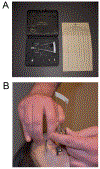The relationship between intraocular pressure and glaucoma: An evolving concept
- PMID: 39303763
- PMCID: PMC12556014
- DOI: 10.1016/j.preteyeres.2024.101303
The relationship between intraocular pressure and glaucoma: An evolving concept
Abstract
Intraocular pressure (IOP) is the most important modifiable risk factor for glaucoma and fluctuates considerably within patients over short and long time periods. Our field's understanding of IOP has evolved considerably in recent years, driven by tonometric technologies with increasing accuracy, reproducibility, and temporal resolution that have refined our knowledge regarding the relationship between IOP and glaucoma risk and pathogenesis. The goal of this article is to review the published literature pertinent to the following points: 1) the factors that determine IOP in physiologic and pathologic states; 2) technologies for measuring IOP; 3) scientific and clinical rationale for measuring diverse IOP metrics in patients with glaucoma; 4) the impact and shortcomings of current standard-of-care IOP monitoring approaches; 5) recommendations for approaches to IOP monitoring that could improve patient outcomes; and 6) research questions that must be answered to improve our understanding of how IOP contributes to disease progression. Retrospective and prospective data, including that from landmark clinical trials, document greater IOP fluctuations in glaucomatous than healthy eyes, tendencies for maximal daily IOP to occur outside of office hours, and, in addition to mean and maximal IOP, an association between IOP fluctuation and glaucoma progression that is independent of mean in-office IOP. Ambulatory IOP monitoring, measuring IOP outside of office hours and at different times of day and night, provides clinicians with discrete data that could improve patient outcomes. Eye care clinicians treating glaucoma based on isolated in-office IOP measurements may make treatment decisions without fully capturing the entire IOP profile of an individual. Data linking home blood pressure monitors and home glucose sensors to dramatically improved outcomes for patients with systemic hypertension and diabetes and will be reviewed as they pertain to the question of whether ambulatory tonometry is positioned to do the same for glaucoma management. Prospective randomized controlled studies are warranted to determine whether remote tonometry-based glaucoma management might reduce vision loss and improve patient outcomes.
Copyright © 2024 The Authors. Published by Elsevier Ltd.. All rights reserved.
Conflict of interest statement
Declaration of competing interest The authors declare the following financial interests/personal relationships which may be considered as potential competing interests:Thomas V Johnson reports financial support was provided by National Eye Institute. Thomas V Johnson reports financial support was provided by Research to Prevent Blindness. Barbara Wirostko reports financial support was provided by Research to Prevent Blindness. Thomas V. Johnson reports equipment, drugs, or supplies was provided by ICARE. Sanjay G. Asrani reports equipment, drugs, or supplies was provided by ICARE. Sanjay G. Asrani, Lama A. Al-Aswad, Craig J. Chaya, Shan Lin, David C. Musch, Ian Pitha, Alan L. Robin, Barbara Wirostko, and Thomas V. Johnson reports a relationship with lighthouse Strategy Consulting that includes: consulting or advisory and travel reimbursement. Barbara Wirosko reports a relationship with MyEyes.com that includes: board membership, employment, and equity or stocks. The Max IOP Consensus Meeting was held in New Orleans, LA on April 22nd, 2023, and chaired by BW and TVJ. The meeting was organized by Lighthouse Strategy Consulting, which was contracted by iCare USA. SGA, BW, LAA, SL, DCM, IP, AR, and TVJ received effort and travel payments from Lighthouse Strategy Consulting for participation in the meeting. Subsequently, the authors drafted the entirety of this manuscript without input, support, or review from either Lighthouse Strategy Consulting or iCare USA. If there are other authors, they declare that they have no known competing financial interests or personal relationships that could have appeared to influence the work reported in this paper.
Figures













References
-
- Quigley HA, Vitale S. Models of open-angle glaucoma prevalence and incidence in the United States. Invest Ophth Vis Sci. Jan 1997;38(1):83–91. - PubMed
Publication types
MeSH terms
Grants and funding
LinkOut - more resources
Full Text Sources
Medical

